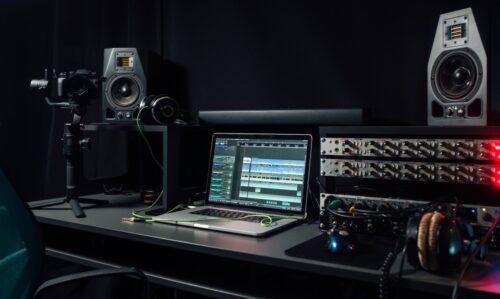What is compression, and how does it affect AV projects? First, we’re not talking about squeezing your favorite tunes into a tiny zip file (although that’s pretty impressive). Audio compression involves reducing an audio signal’s range so it’s easier to listen to. But the tricky part of understanding what is audio compression is balancing too much with too little!
At Voice123 – where you’ll find superb audio pros – we recognize the impact of vocal compression in audio and video. So, here, we unpack what is a compressor and its functions and how these techniques can improve your AV post-production.
Ready to find out what is a compressor?
What is compression?

Compression audio reduces an audio signal’s dynamic range by lowering loudness and boosting softer parts for controlled, consistent volume. Quieter details become more audible without the risk of distortion or overpowering loud sound peaks. If the audio signal were a rollercoaster, compression audio would be the seatbelt, keeping it from catapulting off the tracks into an explosion of sound. So, a moderate ratio of 2:1 to 4:1 can smooth out dynamic peaks, while a medium attack time of around 10-30 ms ensures a fast enough response without distortion.
What is audio compression?
Audio compression is a process that controls an audio file’s range, making it easier to listen to and understand by balancing loud with soft. This is so you don’t listen to audio with a whisper, shout, silence, scream, whisper, shout, repeat – it would exhaust and deafen you. Formats like WAV and AIFF are lossless, so they preserve the original data in larger file sizes without using audio compression techniques.
What is vocal compression?
Vocal compression controls the voice dynamics of audio, making the vocal performance’s volume more even and consistent. It reduces the range between the loudest and softest vocals so the audio doesn’t sound disjointed. Many engineers and executive producers use this technique for musical instruments. On the flip side, if an audio compressor distorts, background noises, like room ambiance or mouth noises, become louder. It can also exacerbate sibilance and plosives, which are exploding p-sounds and ‘esses.’
What is a compressor?
An audio compressor is a device or plugin used in audio engineering and music production to manage an audio signal’s dynamic range. Its primary function is to reduce the volume of loud sounds and amplify softer sounds. But what does a compressor do?
Compressors use vocal compression settings like threshold, ratio, attack, release, and makeup gain. Threshold determines the level vocal compression kicks in, while ratio determines how much a signal’s louder parts are lowered. Attack and release determine how quickly voice compression is applied and released, while makeup gain raises the signal level.
How to use compression audio in projects
1. Set an appropriate threshold
Adjust the threshold to catch the peaks of your audio signal without overcompressing quieter parts. For example, in a podcast, you can catch higher peaks of the host’s voice without squashing their words during quieter moments.
2. Choose the right ratio
Spoken dialogue works with moderate ratios, like 2:1 to 4:1, for naturalness, while music ratios vary depending on instrument or vocal intensity. Higher ratios, like 4:1 to 8:1, work for drums or louder vocals.
3. Adjust attack and release times
Faster attack times, like 10-30 ms, are suitable for controlling sharp transients like drum hits or consonants in speech. Slower release times, like 50-100 ms, preserve the tail end of phrases in dialogue.
4. Apply makeup gain
Use makeup gain to bring the level of the compressed signal back up to match the original, maintaining consistent volume. Aim for a balanced output that complements instead of overpowers your audio mix.
5. Use professional services
Consider outsourcing your audio mastering to experts with the equipment to apply compression audio techniques. Like the pros on Voice123, who’ll often ask, “Would you like me to compress the voice over?”
Final Thoughts

Audio compression is the cornerstone for polished, consistent sound in podcasts, music tracks, films, and more. It’s a useful tool for audio engineers to delicately balance dynamic ranges so every sound—from the softest whisper to the loudest peak—is clear and impactful without distortion.
Working on your next AV project? The pros on Voice123 know the exact vocal requirements for different voice over styles. Or hire our full-scale Managed Services to oversee your project.
Ready to get the awesome audio party started?
FAQs
It’s an audio engineering process that reduces a signal’s dynamic range by lowering louder sounds and making softer ones more audible.
Set parameters like threshold, ratio, attack, release, and makeup gain are tailored to your specific audio content and the desired effect.
They are dynamic range compression, which reduces a signal’s dynamic range, and data compression, which reduces the file size without quality loss.
You must understand threshold, ratio, attack, release, and makeup gain settings to control dynamics while preserving an audio’s natural characteristics.
